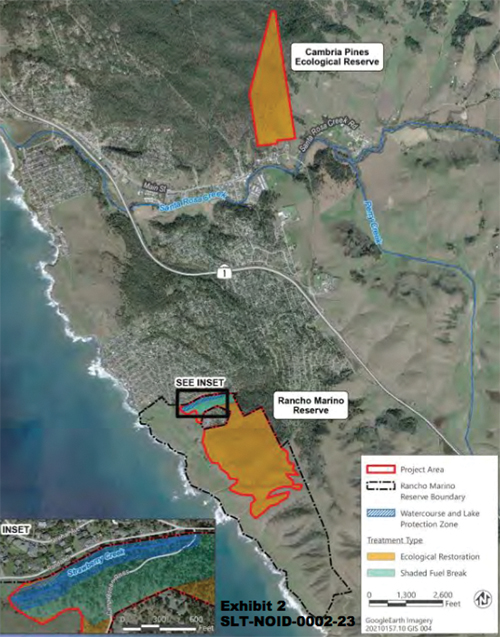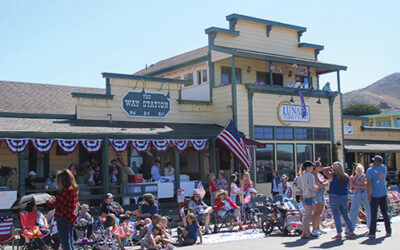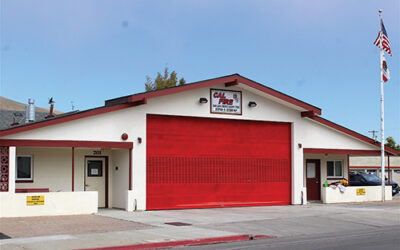A map showing the Cambria burn areas
Two conservation agencies are planning to fight fire with fire in Cambria and they’ve been given permission to fire away by the Coastal Commission.
The Upper Salinas-Las Tablas Resource Conservation District working with the California Department of Fish and Wildlife asked the Commission for a coastal development permit for the “Cambria Reserves Restoration and Vegetation Treatment Project,” a plan to address two large patches of scrub and Monterey Pine forest lands in order to reduce and manage the potential for more catastrophic wildfire.
Much of the land in question is preserved under one plan or another and the total area covers some 291 acres. Some 187 acres lies within the University of California Natural Reserve System’s Kenneth S. Norris Rancho Marino Reserve, according to a Commission report. There’s another 104 acres within the Cambria Pines Ecological Reserve top be treated.
The Norris Rancho Marino Reserve or RMR, as the report refers to it, has 170 acres of vegetation and 17 acres of pine trees, which have been designated as rare and important forestland “in need of restorative management focused on forest health and wildfire prevention,” according to the RMR’s management plan.
“The goals for the proposed vegetation treatments,” the CCC’s report said, “are to increase the health and vigor of the Monterey pine forest, increase biological diversity, and reduce the severity of wildfire.”
The goals are a bit different at the Cambria Pines Reserve; “treatments would consist of ecological restoration treatments, where the goals are to control invasive plants, promote germination and recruitment of Monterey pines to maintain a healthy Monterey pine forest, enhance abundance and diversity of native grasses and forbs in grasslands, maintain rare plant populations, and minimize conditions that lead to catastrophic fire and plant community type conversion.”
It won’t all necessarily get burned, however. “Proposed treatment activities would consist of prescribed burning, manual treatments, mechanical treatments, and herbicide application.
“Vegetation may be left on-site or burned on-site in the form of broadcast burning, pile burning, or using specialized biomass processing technologies (e.g., air curtain burner, carbonator).”
The work is slated to start as soon as possible this year and continue over a 3-year period. Then maintenance treatments of the same sorts and “would be implemented in subsequent years to perpetuate forest and ecosystem health and minimize conditions that lead to catastrophic fire.”
According to the RCD’s plan (see: www.us-ltrcd.org/files/0ac6e16ec/4.+Board+Approved+Cambria+PSA+and+Appendices.pdf), there’s a small area within the RMR, about an acre, that won’t be treated because it’s a wetland, and wetlands are outside the scope of the plan.
The 104-acre Cambria Pines Ecological Reserve is owned and managed by Fish & Wildlife, which acquired the property in 2005. The previous owners used to graze cattle there and in the distant past, it was logged.
The area closest to the town of Cambria is grassland mixed with shrubs. The pine forest covers the majority of the reserve. “The Monterey pine forest in the reserve is part of the Pico Creek-Cambria stand,” the RCD report said, “one of the three natural stands of the species in mainland California.” Fish & Wildlife has designated it as “a sensitive natural community.”
At the other property, the Marino Reserve covers some 591 acres, with the management plan only concerning 187 acres. The pines there are also part of the Pico Creek-Cambria stand of trees, according to the RCD. UCSB runs the RMR.
“The management of RMR by the University of California, Santa Barbara as a research station began in 2001,” the RCD report said. “Historically, the property supported cattle operations beginning in the early 1900s. Currently, cattle graze a small portion of the treatment area along the northern boundary of the reserve.”
The RCD estimates these two areas historically don’t suffer wildlife very often, but they do happen. At the Cambria Reserve records show one small fire of less than half an acre over the 20th and 21st Centuries. Another study in 1990 estimated Monterey Pines in general burn every 1-15 years, before Europeans arrived in the area.
For the Rancho Marino Reserve fire frequency is pegged at every 11-20 years. The rare fire frequencies support the long known threat of wildfire in Cambria, which is famously built interspersed within the pine forest.
At the Cambria Reserve, they also plan “to install a 17-acre shaded fuel break with the primary objective of protecting the campers at Camp Ocean Pines. The proposed shaded fuel break would be implemented in forested habitats that occur between the neighborhood adjacent to the north boundary of RMR and Camp Ocean Pines.”
That shaded fuel break would run adjacent to Randall Road and run 400-500 feet to the border with the Camp Ocean Pines property. It would also cover Strawberry Creek, which the RCD described as a “Class II seasonal creek” with native vegetation.
“At least 75 percent of the overstory and 50 percent of the understory would be retained within the limits of riparian habitat,” the RCD report said, “and equipment limitations, restrictions on pile burning, and additional surface vegetation retention requirements would be implemented in designated watercourse and lake protection zones.” There are also some very steep areas along that stretch of creek that will require extra care.
“Removal of riparian hardwood trees,” the RCD plan said, “would be minimized to the extent feasible, and 75 percent of the native riparian tree canopy would be retained.”
Just how do they intend to get this work done? Using “Mowers, track chippers, chainsaws and other hand tools, backpack or hand sprayers (for herbicide), wildland engines (water during burning), air curtain burner and/or carbonator,” according to the report. They will also use “masticators,” which have metal teeth that grind or chew woody debris in 1 to 2-inch pieces. The head of the masticator can tackle trees and brush up to 4-inches in diameter.



